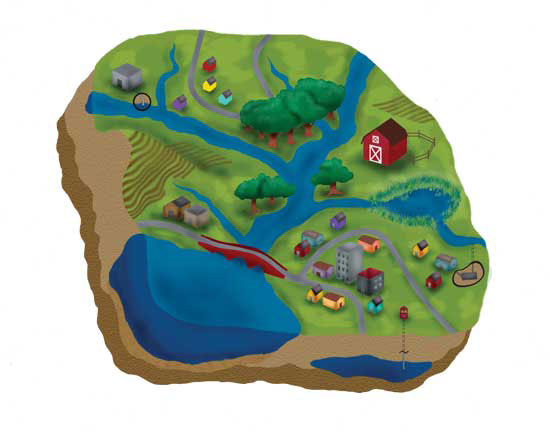 Cleaner water begins in the watershed - an area of land that drains into a lake or stream. Learn about what a watershed is and how it works, what the problems are and how we can work to fix them, and what you and your neighbors can do to help our lakes and streams.
Cleaner water begins in the watershed - an area of land that drains into a lake or stream. Learn about what a watershed is and how it works, what the problems are and how we can work to fix them, and what you and your neighbors can do to help our lakes and streams.
How watersheds work
A watershed is the area of land that drains into a lake or stream. Water traveling over the surface or through groundwater may pick up contaminants like sediment, chemicals and waste and deposit them in a body of water.
We all live in a watershed. Watersheds can be small - like the area that drains into the creek behind your house. Or, watersheds can be large- think of all the land, streams and rivers that drain into the Mississippi River!
The watershed diagram above shows how water runs downhill. Making changes on the land keeps pollutants from rural and urban areas from washing into our water.
Watershed Pollution
The major water quality problem in Iowa is nonpoint source pollution, and it has landed a number of streams and lakes on Iowa's impaired waters list.
Nonpoint source pollution happens when rainfall, snowmelt or irrigation water runs over land or through the ground and picks up pollutants and deposits them into streams, lakes or groundwater. Those pollutants include excess soil, bacteria and nutrients (from farm fertilizers and manure).

Keeping these pollutants out of our water is important for many reasons. People depend on clean water for drinking water and recreation like swimming, boating and fishing. Aquatic life, such as fish, depend on clean water to survive.
Nonpoint source pollution can come from practically any outdoor area that comes into contact with running water, unlike point source pollution, which can be traced back to a specific location or "point," such as an industrial facility, wastewater treatment plant, etc.
The area that nonpoint source pollution comes from is called a "watershed," which is an area of land that drains into a lake or stream. To truly improve Iowa's water quality, we need to clean up watersheds to keep sediment, nutrients and bacteria from washing into streams and lakes.
While nonpoint source pollution is still a large problem, there are many Iowa success stories. Learn more about Iowa's water quality successes.
Common pollutants
The most common nonpoint pollutants are soil (sediment) and nutrients picked up by runoff as it flows over land to surface waters. These pollutants may come from agricultural land and other open spaces, urban areas, construction sites, roads, parking lots and other areas. Other common pollutants include pesticides, pathogens (bacteria and viruses), salts, oil and grease.
In Iowa, sediment is the leading nonpoint source pollutant. Most sediment in Iowa comes from agricultural practices, such as cropland tillage and livestock in pastures, woodlands and feedlots. High levels of eroded sediment also come from construction sites, streambanks and lake shorelines.
Nutrients, especially nitrogen and phosphorus, are other main nonpoint pollutants in Iowa. Nutrients can come from fertilizers (both on agricultural land and on residential lawns, golf courses, etc.) and from organic sources such as manure and human sewage.
Nonpoint source pollution is responsible for sediment that fills in lakes and streams, covers fish habitat, and reduces visibility in the water. It is also often responsible for destroyed fish and wildlife habitat, unsafe drinking water, fish kills, and reduced aesthetic and recreational value of waterbodies. Bacteria from manure or human sewage can cause health problems. Excessive nutrients in water from either chemical fertilizer or organic matter (including manure) can cause algae blooms in lakes, sometimes making lakes smelly and boating difficult. High levels of nutrients in waterbodies can also cause fish kills, by decreasing dissolved oxygen in lakes and streams. Excessive agricultural or lawn chemicals can also cause the water to be unfit for drinking, or require additional and costly treatment.
Solutions for curbing nonpoint pollution
Because nonpoint source pollution is widespread across the state, there is no quick fix to the problem. Improving our streams and lakes requires the help of all Iowans, both urban and rural.
The main solution is prevention. That means keeping excess sediment, nutrients, bacteria and other pollutants out of our water. Because the largest problems come from agricultural areas, an important solution is using conservation practices. Common conservation practices include wetlands, ponds, terraces and buffers. These practices reduce the amount of pollutants reaching a lake or stream.
While agriculture is the largest source of nonpoint pollution in Iowa, urban areas can also work to improve our water. Some urban solutions include managing lawn fertilizers, keeping pollutants out of storm drains and keeping excess soil from construction sites out of streams and lakes.
More information on nonpoint source pollution:
Additional watershed topics
A watershed approach to improving rivers, lakes and streams takes a wide view. Other issues related to watershed improvement include:
Stormwater
Lake restoration
Shallow lake restoration
Trout stream restoration
Drinking water
Source water protection
Impaired waters
Water quality standards
Water monitoring
Volunteer water monitoring
River trails and paddling
Fisheries
DNR forestry landowner assistance
DNR private lands assistance
Environmental management systems
For more information, see the Contact Watershed Staff Page